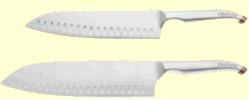
8" FX501 and 10" FX507 Cook's with Coppertail

8" FX514 and 9" FX519 East/West with Coppertail
| When Füritechnics developed the Pro knives, the only available sharpening methods were gadgets or traditional steel/stone. Their research showed that the former didn't produce a correctly honed edge, and the latter required a lot of skill and still involved a lot of human error, but at least produced the correct hone for professional cutting situations. | |||||
| Because of the difficulty in sharpening/honing of CrMoV knives with traditional Steel/hone, they worked on using an alloy that had the best combination of ease of sharpening (to sharpen/hone just like carbon steel), edge retention and corrosion resistance, for professional cooks. |
 8" FX501 and 10" FX507 Cook's with Coppertail |
||||
| While they were developing the FX forging method, they also developed the Tech Edge sharpening system. It quickly became obvious that this sharpening system would finally solve the problem of sharpening/honing CrMoV materials, and that ease of sharpening as a material property would be largely redundant for anyone who owned a Tech Edge. The German CrMoV material they for FX is easily sharpened on Tech Edge, but will be as difficult to sharpen as other brands using traditional methods. | |||||
 8" FX514 and 9" FX519 East/West with Coppertail |
|||||
| So its advantages include slightly better corrosion resistance, and slightly longer edge retention (particularly if cutting on hard/abrasive surfaces). Its disadvantages include material cost and more difficulty in sharpening/honing with traditional methods. The relative merits usually become irrelevant once a chef picks up and uses the FX knives: it is immediately obvious that they are something very special. However, the properties and expense of FX knives are not as important for smaller knives, so we've only used this technology for our largest hardest-working models. | |||||
| About Füri | |||||